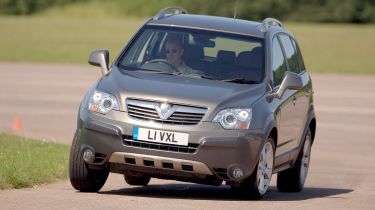Vauxhall Antara 2.0 CDTI SE
After a four-year absence from the class, Vauxhall is back in business
We're surprised that Vauxhall let its presence in the SUV class lapse. The Frontera may not have been particularly good – it used a crude ladderframe chassis – but it was a big seller, and cried out for more investment and an urgent replacement when it finally died in 2003.
Instead, Vauxhall has sat on the sidelines for four years while cars such as the Nissan X-Trail and Honda CR-V reaped the rewards. But it has to be said that the firm hasn’t wasted its time. The Antara is a handsome machine, easily more attractive than the Chevrolet Captiva with which it has so much in common.
It’s not as upmarket as the Land Rover Freelander, but looks quite compact in the metal. However, that’s slightly misleading, because although it’s the shortest car here, only the Wrangler is wider or taller. Unfortunately, the generous exterior dimensions don’t translate into a spacious cabin. Open the narrow tailgate, and you’re greeted by a high load lip and not much floor space. A 370-litre boot is simply too small.
Further forward, the cabin is finished to a high standard. In terms of design and materials used, the Antara is ahead of its rivals. The X-Trail has a narrow edge for construction and toughness, but the Vauxhall’s cabin is a nicer place to spend time. Yet this smart appearance has come at the expense of practical stowage. There are no cup-holders, while storage space is inadequate.
And then there’s the engine. The 2.0-litre unit produces identical power and torque to the Nissan, but against the clock it lagged well behind. You don’t have to look far to spot why, as the Antara’s 1,810kg kerbweight and 0.38Cd drag factor work against it. Throw in a slack, short-geared five-speed manual (70mph equals 2,800rpm), and it’s no wonder the Antara’s 10.6 second 0-60mph time was 1.3 seconds slower than the X-Trail’s.
In-gear times are more competitive due to the Antara’s comparatively close ratios, and while the engine itself never feels as muscular as the Citroen’s or Nissan’s, it pulls well from 1,700rpm and retains its composure even when used hard.
But while the engine is good to use, the brakes are very poor. There’s no bite, the pedal is soft and stopping distances would be a joke if the Jeep’s and Nissan’s weren’t as disappointing. However, while weak brakes are one of the few holes in the X-Trail’s defences, the Antara’s stoppers are indicative of the rest of the driving experience.
The soft ride ensures the Vauxhall is soothing on smooth roads – self-levelling suspension is standard on all diesels – but on uneven tarmac its lack of control is unnerving. It bounces over bumps rather than absorbing them, rolls heavily and has vague steering – there’s a small but disconcerting delay between turning the wheel and anything happening. Given how good to drive Vauxhall’s Corsa and Astra hatchbacks are, the Antara comes across as disappointingly under-developed. It’s not even that great off-road, with none of its rivals’ trick 4WD systems.
At least it cruises quietly, and you also have plenty of kit on board. This SE model has sat-nav, Bluetooth, xenon lights and eight airbags. Even so, its £26,320 asking price is high – the equivalent range-topping seven-seat Zafira costs £6,000 less. Also, why isn’t the Antara available with extra chairs like its Chevrolet Captiva sister? That looks like a short-sighted decision on Vauxhall’s part, and could undermine its performance here.
Details
Price: £26,320
Model tested: Vauxhall Antara 2.0 CDTI SE
Chart position: 3
WHY: Why? Vauxhall is aiming to set new standards for refinement and comfort in the compact SUV class.
Economy
Due to weight, poor aerodynamics and short gearing (600-800rpm higher than rivals at 70mph), the Antara returned 29mpg. Annual fuel costs are £200 above the Nissan’s.
Residuals
You’ll pay £5,000 more to own the Vauxhall than the Nissan, but three years down the line it’ll be worth less. The auto option fares 1.5 per cent worse than the manual.
Servicing
Dealers haven’t yet calculated servicing costs, although we expect the Antara to be the cheapest here to maintain, not least as it has generous 20,000-mile intervals.







